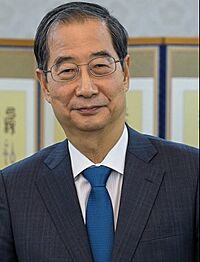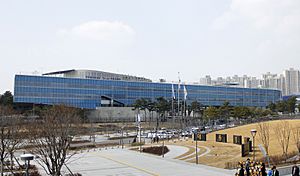Prime Minister of South Korea facts for kids
Quick facts for kids Prime Minister of theRepublic of Korea |
|
|---|---|

Standard of the Prime Minister
|
|

Emblem of the Prime Minister
|
|
| Executive branch of the Government of South Korea Prime Minister's Office |
|
| Style |
|
| Member of |
|
| Residence | Chongni Gonggwan |
| Seat | Sejong City |
| Nominator | President |
| Appointer | President (Subject to the National Assembly's approval) |
| Term length | At the President's pleasure |
| Constituting instrument | Constitution of South Korea |
| Precursor | Prime Minister of the Provisional Government of the Republic of Korea |
| Inaugural holder | Lee Beom-seok |
| Formation | 31 July 1948 |
| Deputy | Deputy Prime Minister |
| Salary | ₩191,000,000 annually |
| Website | |
| Prime Minister of South Korea | |
| Hangul |
국무총리
|
|---|---|
| Hanja |
國務總理
|
| Revised Romanization | gungmuchongni |
| McCune–Reischauer | kungmuch'ongni |
The prime minister of the Republic of Korea (Hangul: 국무총리; Hanja: 國務總理) is the deputy head of government and the second highest political office of South Korea. The prime minister is appointed by the president of the Republic of Korea, with the National Assembly's approval. The prime minister may be a member of the National Assembly, but this is not required to hold the office.
Unlike prime ministers of parliamentary democracies, the prime minister of South Korea is not the head of government of South Korea but as a senior member of the cabinet, since the president is both the head of state and head of government in the country. The prime minister is the principal executive assistant to the president, and is first in the order of succession; the prime minister assumes the presidency in acting capacity, upon the removal or incapacitation of the sitting president, similar to the vice president of the United States.
The current prime minister is Han Duck-soo, having taken office on 20 May 2022. After his impeachment on 27 December 2024, deputy prime minister and Finance Minister Choi Sang-mok briefly held the role of acting prime minister before his reinstatement on 25 March 2025 by the Constitutional Court of South Korea. Han is also serving as the acting president of South Korea since December 2024 and since March 2025, due to the Impeachment and removal of Yoon Suk Yeol.
Contents
Nomenclature
The Sino-Korean word gungmu (국무/國務) means "state affairs" and chongni (총리/總理) means "prime minister", "premier" or "chancellor", so the full title in Korean means literally "Prime Minister for State Affairs", but it is not used as official English title. The short title in Korean is simply Chongni.
History
The position was created on 31 July 1948, two weeks before the government of South Korea was founded, and was held by Lee Beom-seok until 1950. During the Second Republic a parliamentary system was established and the prime minister became the most powerful position, with the president reduced to a figurehead. Chang Myon was the only prime minister of the second republic until the military coup of 1961. The title was Chief Cabinet Minister from 1961 until 1963.
On 27 April 2014, Prime Minister Chung Hong-won announced his desire to resign. However, due to unsuccessful nominations, Chung remained in office until February 2015.
On 23 January 2015, President Park Geun-hye named Saenuri's Floor Leader Lee Wan-koo as the new prime minister. Lee was confirmed by the National Assembly as Prime Minister on 16 February 2015. However, on April 20 of the same year, he offered his resignation to the president in the midst of a bribery scandal.
Functions
The prime minister is the principal executive assistant to the president, with the president being the actual head of government. The prime minister holds the second position after the president in the State Council of South Korea, which is the nominal cabinet of South Korea. The prime minister assists the president by supervising ministries, making recommendations for ministers, and serves as the vice-chairperson of the Cabinet. The prime minister is the first in the order of succession to discharge the duties of the office of the president as the acting president should the president be unable to discharge their office. The most recent prime minister to have served as Acting President is Han Duck-soo, during the suspension of Yoon Suk Yeol due to his impeachment on 14 December 2024. The role of the prime minister is more akin to the Vice President of the United States than it is to the prime ministers of parliamentary democracies.
A prime minister that has been appointed by the president but not yet confirmed by the National Assembly is informally called as the acting prime minister. The term may also be applied to a prime minister that has resigned but in the interim remains in office in a caretaker role.
The prime minister is supported by two deputy prime ministers, one of whom acts for the prime minister in the event of an impeachment. The prime minister of South Korea sometimes holds some professional or technological knowledge whereas the president is always a sole politician.
Removal
The procedure for impeachment is set out in the 10th Constitution of South Korea in 1987. And according to Article 65 Clause 1, if the president, prime minister, or other state council members violate the Constitution or other laws of official duty, the National Assembly can impeach them.
Clause 2 states the impeachment bill must be proposed by one third, and approved by a majority of members of the National Assembly for passage. This article also states that any person against whom a motion for impeachment has been passed shall be suspended from exercising their power until the impeachment has been adjudicated by the Constitutional Court of Korea, and a decision on impeachment shall not extend further than removal from public office. However, impeachment shall not exempt the person impeached from civil or criminal liability for such violations.
By the Constitutional Court Act of 1988, the Constitutional Court must make a final decision within 180 days after it receives any case for adjudication, including impeachment cases. If the respondent has already left office before the pronouncement of the decision, the case is dismissed.
In Han Duck-soo's case, the Constutional Court of South Korea dismissed the case, thus automatically restoring him to both the prime ministership and the acting presidency.
Prime Minister's Office
The Prime Minister's Office consists of two organisations – the Office for Government Policy Coordination and the Prime Minister's Secretariat which are led by ministerial-level minister for government policy coordination and vice-ministerial-level chief of staff to the prime minister respectively.
Office for Government Policy Coordination assists the prime minister with:
- various tasks, responsible for directing, adjusting and overseeing central administrative authorities underneath the Prime Minister's Office;
- planning and adjusting key national policies;
- managing, analyzing and assessing policies in regard to social risks, conflicts and pending problems;
- implementing regulatory reform;
- and doing other tasks specifically delegated by the prime minister.
Prime Minister's Secretariat assists the prime minister with:
- activities related to the National Assembly, responsible for matters regarding collaboration between the executive branch and the majority party in the legislature;
- providing PM with counsel on state affairs;
- matters regarding key information and situations both domestic and international;
- management and arbitration of civil complaints;
- supporting and collaborating with civil groups;
- promoting PM's activities in relation to state affairs;
- drafting PM's remarks and statements;
- supporting the promotion of activities by the Office for Government Policy Coordination;
- protocols and armed escort regarding PM and receiving VIPs;
- maintaining the official residence of PM;
- and handling other matters as instructed by PM.
Salary
The prime minister has a salary of US$163,000 as set by the National Assembly along with a lifelong pension that is always given to former prime ministers.
Residence
The prime minister's residence is Chongni Gonggwan. It is owned and operated by the South Korean government, and has served as the residence of the prime minister since the early 1990s after construction was concluded and was completed around the same time as the Presidential Blue House.
Post-premiership
All former prime ministers are given a lifelong pension and a Presidential Security Service detail but do not have to accept the protection if they so wish. Prime ministers when they die usually have a state funeral so the public and government officials both past and present can pay their respects.
Lists of prime ministers
See also
 In Spanish: Primer ministro de Corea del Sur para niños
In Spanish: Primer ministro de Corea del Sur para niños
- Politics of South Korea
- Premier of North Korea
- Prime Minister of the Korean Empire



